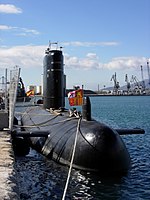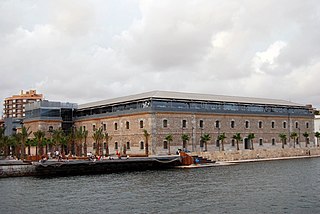
The list of submarines in the Spanish Navy, commissioned or otherwise operated by the Spanish Navy.

The list of submarines in the Spanish Navy, commissioned or otherwise operated by the Spanish Navy.







French Daphné class submarine built in Spain under license

French Agosta class submarine built in Spain under license
Narcís Monturiol i Estarriol was a Spanish inventor, artist and engineer born in Figueres, Catalonia. He was the inventor of the first air-independent and combustion-engine-driven submarine.

The Greater Underwater Propulsion Power Program (GUPPY) was initiated by the United States Navy after World War II to improve the submerged speed, maneuverability, and endurance of its submarines. (The "Y" in the acronym was added for pronounceability.)

The Balao class was a design of United States Navy submarine used during World War II, and with 120 boats completed, the largest class of submarines in the United States Navy. An improvement on the earlier Gato class, the boats had slight internal differences. The most significant improvement was the use of thicker, higher yield strength steel in the pressure hull skins and frames, which increased their test depth to 400 feet (120 m). Tang actually achieved a depth of 612 ft (187 m) during a test dive, and exceeded that test depth when taking on water in the forward torpedo room while evading a destroyer.

Tench-class submarines were a type of submarine built for the United States Navy (USN) between 1944 and 1951. They were an improvement over the Gato and Balao classes, only about 35 to 40 tons larger, but more strongly built and with a slightly improved internal layout. One of the ballast tanks was converted to carry fuel, increasing range from 11,000 nautical miles to 16,000 nautical miles. This improvement was also made on some boats of the previous two classes. Further improvements were made beginning with SS-435, which are sometimes referred to as the Corsair class. Initial plans called for 80 to be built, but 51 were cancelled in 1944 and 1945 when it became apparent that they would not be needed to defeat Japan. The remaining 29 were commissioned between October 1944 (Tench) and February 1951 (Grenadier). The last submarine of the Tench class, as well as the last submarine which served during World War II, remaining in service with the U.S. Navy was USS Tigrone (AGSS-419) which was decommissioned on 27 June 1975.

USS Clamagore (SS-343) was a Balao-class submarine, which operated as a museum ship at the Patriot's Point Naval & Maritime Museum outside Charleston, South Carolina from 1979 to 2022. Built in 1945 for the United States Navy, she was still in training when World War II ended. She was named for the clamagore. A National Historic Landmark, she was the last surviving example of a GUPPY III type submarine. On 15 October 2022, the USS Clamagore, stripped of sail and superstructure was removed from Patriots Point and towed to Norfolk VA to begin final recycling.

USS Jallao (SS-368), a Balao-class submarine, was a ship of the United States Navy named for the jallao, a pearl-white haemulonid food fish of the Gulf of Mexico.
USS Kraken (SS-370), a Balao-class submarine, was a ship of the United States Navy named for the kraken, a legendary sea monster believed to haunt the coasts of Norway.

Ictíneo II was a pioneering submarine Its launching took place in the Port of Barcelona on October 2, 1864 by the Spanish engineer Narciso Monturiol and it was the first air independent and combustion powered submarine and the first submarine to overcome the basic problems of machine powered underwater navigation.

C-3 was a C-class submarine of the Spanish Republican Navy. C-3 was built by Sociedad Española de Construcción Naval (SECN) in Cartagena, Spain, launched 20 February 1929, and commissioned on 4 May 1929. She took part in the Spanish Civil War on the government side before being sunk by the German submarine U-34 on 12 December 1936.

The S-80 Plus class is a Spanish class of four submarines being built by the state-owned Spanish company Navantia at its Cartagena shipyard for the Spanish Navy. In common with other contemporary submarines, they feature air-independent propulsion.
Narcíso Monturiol may refer to one of the following submarines of the Spanish Navy named after submarine pioneer Narcís Monturiol:
Peral was the first successful full electric battery-powered submarine, built by the Spanish engineer and sailor Isaac Peral for the Spanish Navy, in Arsenal de la Carraca. The first fully capable military submarine, she was launched 8 September 1888. She had one torpedo tube and an air regeneration system. Her hull shape, propeller, periscope, torpedo launcher and cruciform external controls anticipated later designs. Her underwater speed was 3 knots. With fully charged batteries, she was the fastest submarine yet built, with underwater performance levels that matched those of First World War U-boats for a very short period, before her batteries began to drain. For example, the SM U-9, a pre-war German U-boat built in 1908, had an underwater speed of 8.1 knots, and an underwater range of 150 km (81 nmi) at 5.8 knots, before having to resurface to recharge her batteries. Although advanced in many ways, Peral lacked a means of charging batteries while underway, such as an internal combustion engine, thus had a very limited endurance and range. In June 1890, Peral's submarine launched a torpedo while submerged. It was also the first submarine to incorporate a fully reliable underwater navigation system. However, conservatives in the Spanish naval hierarchy terminated the project despite two years of successful tests. Her operational abilities have led some to call her the first U-boat.
Spanish submarine Isaac Peral is the name used by four submarines in the Spanish navy after captain and submarine pioneer Isaac Peral.

The Spanish Republican Navy was the naval arm of the Armed Forces of the Second Spanish Republic, the legally established government of Spain between 1931 and 1939.

Cosme García Sáez was a Spanish inventor. It is claimed that he was first to invent a submersible, preceding those of Narciso Monturiol and Isaac Peral. He was self-taught without formal training in engineering. However, three naval submarines have been named after him.

The Clase Tiburón submarines, was a mini submarines class of the Spanish Navy built in 1964. Only two units were built. Currently, Tiburón-I (SA-51) is conserved as a museum ship in Barcelona and Tiburón-II (SA-52) in Cartagena.

The Cartagena Naval Museum is a military museum near the city port of Cartagena, Spain. It presents exhibitions related to naval construction. It is a subsidiary of the Naval Museum of Madrid.

Delfín is a diesel-electric submarine of the Daphné class that was used by the Spanish Navy between 1973 and 2003. During the submarine's 30 years of service, the vessel participated in various national and international exercises and maneuvers, made more than 2,500 voyages, more than 30,000 hours of immersion and served in this submarine more than a thousand sailors. At the time of her retirement, she was the longest-serving submarine in the history of the Spanish Submarine Fleet.